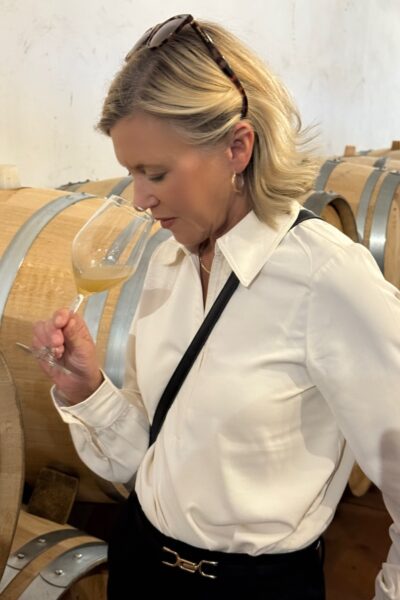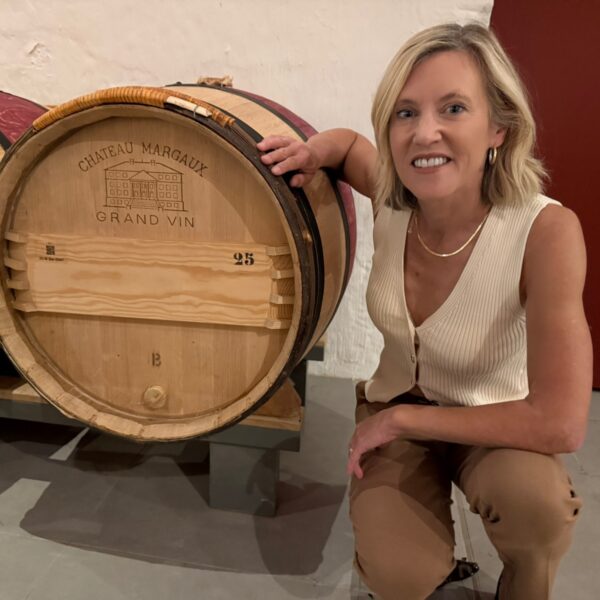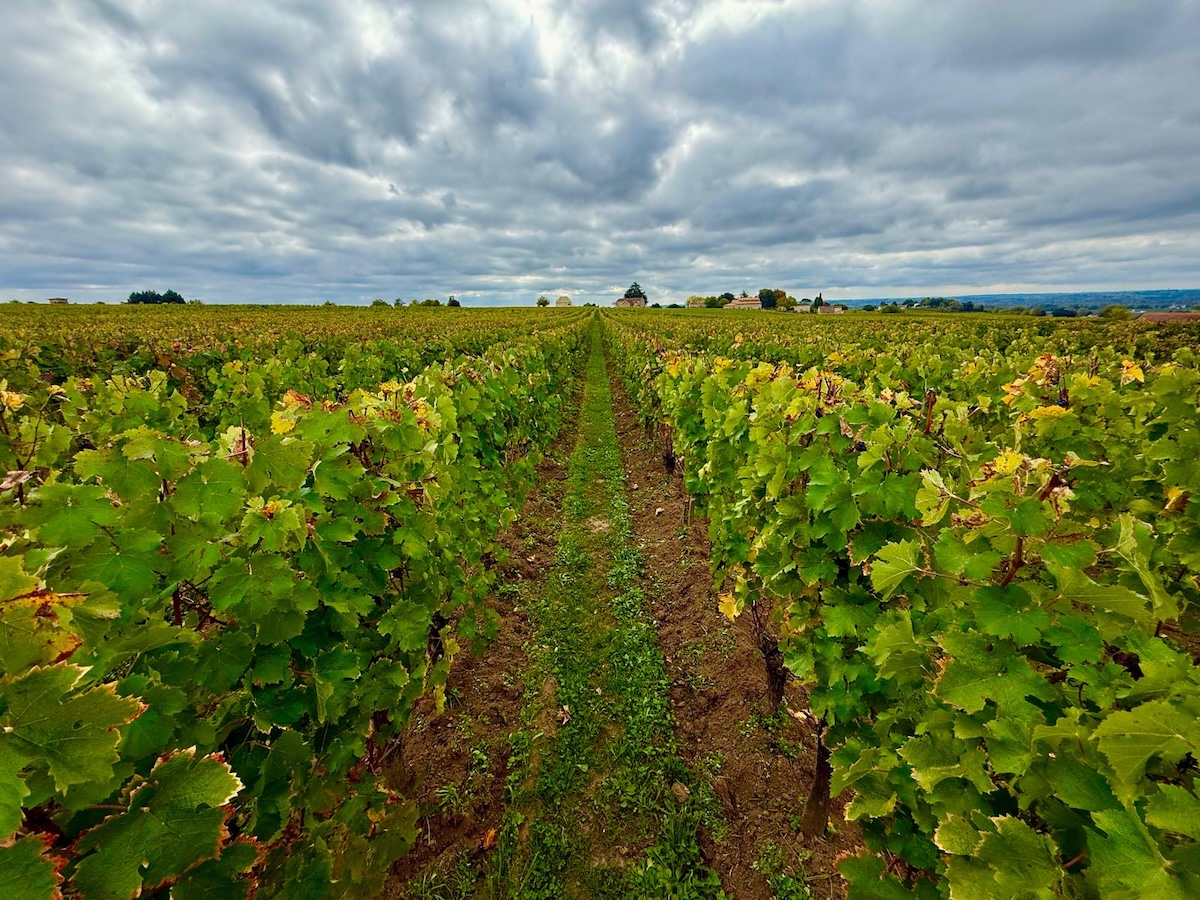Climate change continues to impact the Bordelaise.
Extreme weather events such as storms, hail, drought, wildfires,
and frost pose an ever-growing risk to yields and fruit quality.
To survive, growers must adapt and act quickly. Last year, the season was plagued by rain and mildew, while 2025’s early, dry spring brought hope. Budding started around March 27, followed by a rapid, even flowering in mid-May, a week earlier than average. The little rain that fell in July kept everyone optimistic, and then, the temperatures started to rise. For 11 days, the mercury climbed to over 35C, with August 12 hitting 41.6C, a record-breaking high. Too much heat can cause unbalanced sugar and acidity, degradation of flavour compounds, and damage to the berries. They may shrivel or become sunburned.
Once again, climate change, and particularly the Bordeaux stance on irrigation, became a hot topic on many social media platforms. Then, on August 27, Château Lafleur dropped a bombshell, sending shockwaves through Bordeaux. They were leaving the Pomerol AOC. From the 2025 vintage onwards, all six of their wines would be classified as Vins de France. LaFleur cited climate change as a reason, paired with the rigidity of an appellation system that was not adapting quickly enough to the new realities of viticulture. Social media exploded! Had Lafleur gone ahead and irrigated their vines? And would their decision spark a debate–or even change the rules and restrictions of the existing AOC?

On my recent trip to Bordeaux, these questions lingered like the yeasty scent of fermenting must at every château visited. Yet, given the topic, I was surprised by the vines’ overall health and vigour. I expected to see signs of drought stress, such as wilted leaves, scorched leaf margins, or stunted growth. Not so. In fact, every winemaker we spoke to was overwhelmingly optimistic about the 2025 vintage.
The harvest marked the earliest on record, with the first white grapes coming in around mid-August. Most classified growths in Graves and Médoc began harvesting Sauvignon Blanc on August 18 and 19. In Saint-Émilion, Château Troplong Mondot started harvesting Merlot on Tuesday, August 26, three weeks earlier than usual. Across the region, other estates followed suit with Merlot. The harvest of Cabernet Sauvignon commenced on September 15 for the majority of estates, again three weeks earlier than usual.
Rain did come to the region in early September, with 100mm falling in Pauillac, 90mm in
Saint Estèphe, and similar amounts across most of the area, with a little less on the right bank.
Though a welcome blessing at first, too much water after drought poses a challenge for vines. If
water is absorbed too quickly, the berries risk splitting. Estates with younger vines or poorer
soils had to harvest quickly. Alternatively, those with resilient soil or older vines benefited from
the rain. The berries grew plump with juice, lowering the potential alcohol. Those growers had
the luxury of waiting for the natural sugar levels to rise again while the ripening continued.
Soil structure is an interesting topic. Nicolas Glumineau, General Manager of Pichon Comtesse de Lalande, felt that the lack of water was not the problem in Bordeaux. The area experiences a moderate maritime climate with year-round rainfall, which maintains the water table. The gravelly soils of Pauillac force the roots to seek out water and nutrients. It’s not unusual for roots to reach 3 meters below the surface. Instead, Glumineau explained that the challenge lies in managing the soil’s surface structure to help the vines cope with fluctuating weather patterns.
Cover crops help. First, water competition forces the vines’ roots deeper into the soil. Second, through natural decomposition, cover crops provide organic matter to the soil. This humus not only breaks up compacted soil but also binds soil particles into aggregates, thus improving aeration, water infiltration, and retention. Glumineau also praised the vine’s ability to adapt to higher temperatures—suggesting that the stress of 2022 helped prepare the vines for 2025.
At Pontet Canet, the region’s first biodynamic-certified property, the estate also embraces the merits of dry farming, asserting that a vine that struggles produces a wine with higher concentration and flavour. Again, the estate was pleased and optimistic with the 2025 harvest. Yields were low, but the quality was high. Pontet Canet’s gravelly soils sit over limestone bedrock that acts like a sponge in wet weather. To help the vines thrive and avoid soil compaction caused by machinery, the estate has turned to horse-powered work in the vineyards. Horse-drawn ploughs break up surface roots and encourage deep root growth.

Similar views were expressed across the Médoc from Saint-Estèphe to Margaux. The vines had managed the heat stress remarkably well. Winemakers are confident that the grapes reached phenolic ripeness and that the vintage shows promise of maintaining the five-year trend. There’s a theory in Bordeaux that a great vintage happens every five years—2000, 2005, 2010, 2015, 2020…
On the right bank, estates also remained enthusiastic about the vintage. Last year’s wet weather left sufficient water in the clay-based soils. Though yields were small, conditions led to highly concentrated aromatic berries with high sugar levels and abundant tannins. The decision to pick early helped balance freshness. Vineyard management techniques remain the focus over irrigation. Where once, deleafing around grape clusters was standard practice, today growers adjust the canopy to help shade the grapes from the sun’s intensity. New plantings are oriented in either a northeast-southwest direction or east-west direction to help minimize the grapes’ exposure to the intense afternoon sun. Château Cheval Blanc has planted trees to help shade their precious berries.
In Barsac and Sauternes, the estates we visited remained enthusiastic. Following August’s heat wave, September’s well-timed rains refreshed the grapes and triggered the noble rot to concentrate the sugars and flavours. Harvesting took place over the first two weeks of October under perfect conditions: misty mornings, followed by dry sunny afternoons, and cool nights. Vignerons expect the wines to emphasise freshness and finesse with balanced alcohol levels.
So, what about irrigation? First, it’s a myth that Bordeaux doesn’t allow irrigation. Newly planted vines can be irrigated for the first two years to help their roots establish. Second, since 2022, Pessac-Leognan, Pomerol, and Saint-Émilion have included a clause in their Cahiers de Charge (AOC rulebook) allowing irrigation only if extreme heat or drought warrants it. The request must come from the entire appellation, not from an individual. For background, the AOCs were created to combat fraud and ensure quality and consistency across a region. They may be restrictive, but everyone has the same rules.
April’s en primeur campaign will show a first glimpse at what the 2025 vintage will become, and time will tell whether it lives up to the initial hype. As for Lafleur, they’ve chosen to set their own rulebook—one that’s less restrictive and more creative. But in doing so, they’ve left the Pomerol league.
MyVanCity.ca would like to welome Kim Meadow @agalandaglass


An informative and enjoyable read. Thanks, Kim and welcome to the team.